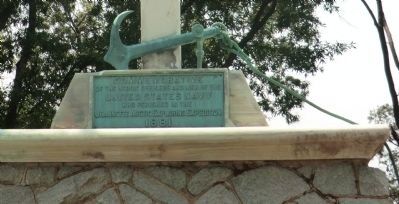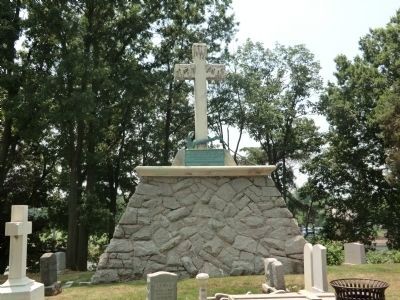Naval Academy in Annapolis in Anne Arundel County, Maryland — The American Northeast (Mid-Atlantic)
Jeannette Arctic Exploring Expedition
Topics. This historical marker is listed in this topic list: Exploration. A significant historical year for this entry is 1881.
Location. 38° 59.232′ N, 76° 29.43′ W. Marker is in Annapolis, Maryland, in Anne Arundel County. It is in Naval Academy. Marker is on Cemetery Road-U.S. Naval Academy. Touch for map. Marker is at or near this postal address: 50 Ramsey Rd, Annapolis MD 21402, United States of America. Touch for directions.
Other nearby markers. At least 8 other markers are within walking distance of this marker. Husband Edward Kimmel (within shouting distance of this marker); Henry Hays Lockwood (within shouting distance of this marker); Evolutions of Strawberry Hill (about 400 feet away, measured in a direct line); Terwilliger Brothers Field (approx. ¼ mile away); Sons of the Revolution (approx. ¼ mile away); St. John's College (approx. ¼ mile away); Classes of 1958 and 1959 Memorial Plaza (approx. ¼ mile away); Max E Bishop (approx. 0.3 miles away). Touch for a list and map of all markers in Annapolis.
More about this marker. Naval History and Heritage Command
Jeannette Arctic Expedition, 1879-1881
Overview and Selected Images
From 1879-1881 thirty-three Navy officers, enlisted men and civilians, led by Lieutenant Commander George Washington DeLong, participated in an epic Arctic adventure that defines the limits of human will and endurance in an overwhelmingly distant and hostile environment. The undertaking began optimistically on 8 July 1879, when the Navy operated, but privately owned, steamer Jeannette left San Francisco, California, for an attempt to reach the North Pole through what was then believed to be open water beyond the Arctic icepack. The ship entered the ice to the east of Wrangell Island on 6 September and, as expected, was held fast within a few days.
Jeannette remained in the ice as it drifted erratically to the northwest during the rest of 1879, all of 1880 and the first half of 1881. During this time, her crew occupied themselves maintaining their ship, making scientific observations, hunting seals and polar bears and, in May 1881, landing on Henrietta Island, some 600 miles from Wrangell. With DeLong's leadership and careful planning, plus the inspired care of Passed Assistant Surgeon James M. Ambler, their health generally remained good, and the ship, though leaking somewhat, was still sound. In June 1881 the ice parted and hopes were entertained that they might reach open sea, but on the 12th the flows closed in with such force that Jeannette's hull was crushed. Her crew removed three boats, supplies and some equipment and, after a few days' rest, began a long and very difficult trek, dragging the boats over the rugged ice so they would have means to proceed when open water was reached.
Their goal was the Lena River Delta, nearly 700 miles away on the north Siberian coast. In late July, after a journey prolonged by ice movement, they landed on Bennett Island, still far from the mainland. Resuming the slog, Jeannette's men headed southwards through the New Siberian Islands, reaching Kotelnoi and Simonoski Islands in early September, after which the way was clear to sail to the Lena Delta. On 12 September 1881, however, the three boats separated in a storm. One, commanded by Lieutenant Charles W. Chipp and occupied by seven other men, was not seen again. The other two, commanded by DeLong with thirteen others and Chief Engineer George W. Melville with ten others, landed far apart on the delta.
Melville's party soon encountered local inhabitants and were saved. DeLong and his thirteen men waded ashore through the nearly frozen water and began to trudge south over the desolate terrain. After one man died of the effects of frostbite and the others were weakened by exposure and hunger, Seamen Nindemann and Noros were sent ahead to find help. Before that materialized, the remaining eleven succumbed, with DeLong and two others surviving perhaps a few days beyond 30 October 1881, when he made his final journal entry. The bodies of ten were discovered in March 1882, as Melville conducted an exhausting search for the other members of the expedition, and were transported back to the United States in early 1884.
Credits. This page was last revised on September 10, 2023. It was originally submitted on November 13, 2012, by Don Morfe of Baltimore, Maryland. This page has been viewed 424 times since then and 11 times this year. Photos: 1, 2. submitted on November 13, 2012, by Don Morfe of Baltimore, Maryland. • Bill Pfingsten was the editor who published this page.

